rims FORD F650 2015 13.G Owners Manual
[x] Cancel search | Manufacturer: FORD, Model Year: 2015, Model line: F650, Model: FORD F650 2015 13.GPages: 384, PDF Size: 4.95 MB
Page 19 of 384
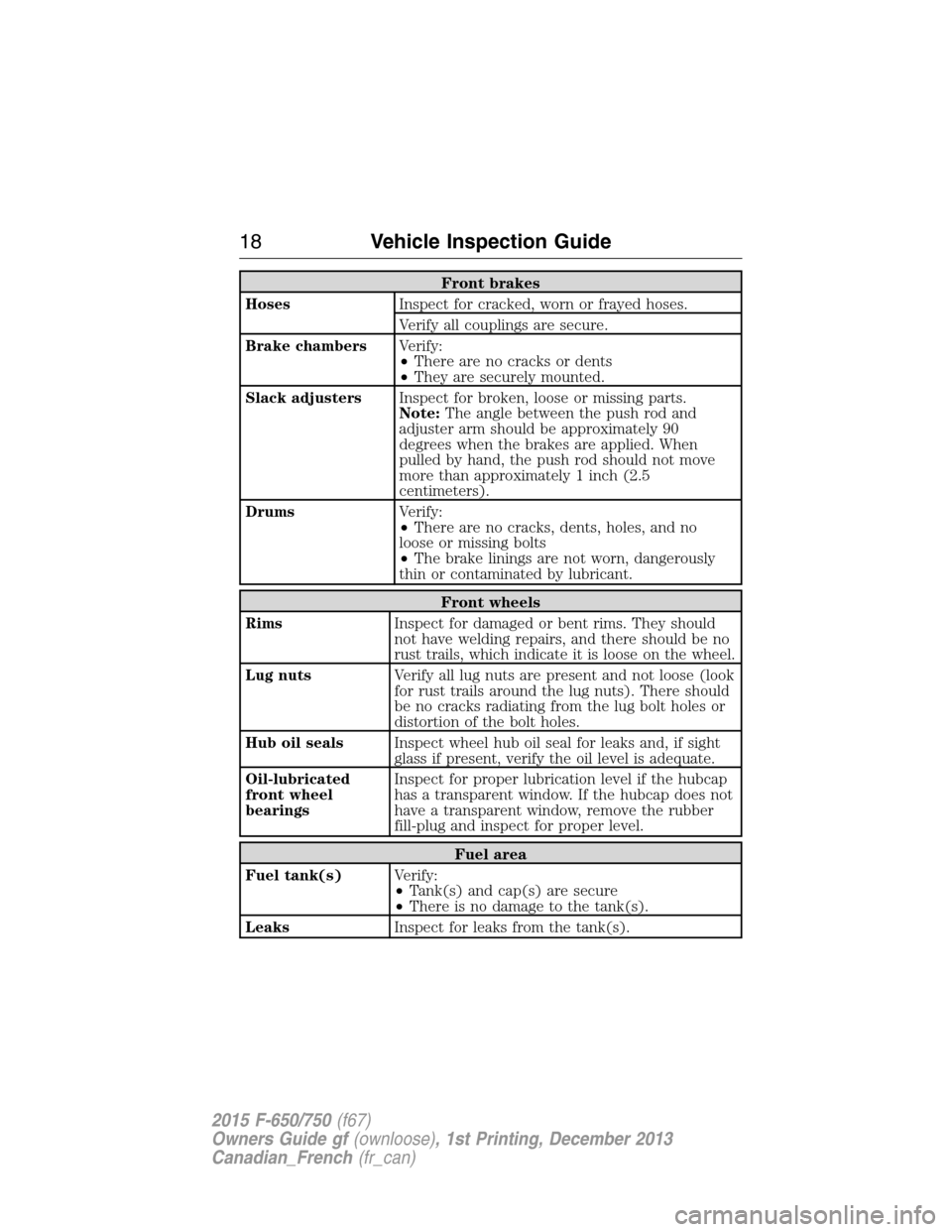
Front brakes
HosesInspect for cracked, worn or frayed hoses.
Verify all couplings are secure.
Brake chambersVerify:
•There are no cracks or dents
•They are securely mounted.
Slack adjustersInspect for broken, loose or missing parts.
Note:The angle between the push rod and
adjuster arm should be approximately 90
degrees when the brakes are applied. When
pulled by hand, the push rod should not move
more than approximately 1 inch (2.5
centimeters).
DrumsVerify:
•There are no cracks, dents, holes, and no
loose or missing bolts
•The brake linings are not worn, dangerously
thin or contaminated by lubricant.
Front wheels
RimsInspect for damaged or bent rims. They should
not have welding repairs, and there should be no
rust trails, which indicate it is loose on the wheel.
Lug nutsVerify all lug nuts are present and not loose (look
for rust trails around the lug nuts). There should
be no cracks radiating from the lug bolt holes or
distortion of the bolt holes.
Hub oil sealsInspect wheel hub oil seal for leaks and, if sight
glass if present, verify the oil level is adequate.
Oil-lubricated
front wheel
bearingsInspect for proper lubrication level if the hubcap
has a transparent window. If the hubcap does not
have a transparent window, remove the rubber
fill-plug and inspect for proper level.
Fuel area
Fuel tank(s)Verify:
•Tank(s) and cap(s) are secure
•There is no damage to the tank(s).
LeaksInspect for leaks from the tank(s).
18Vehicle Inspection Guide
2015 F-650/750(f67)
Owners Guide gf(ownloose), 1st Printing, December 2013
Canadian_French(fr_can)
Page 22 of 384
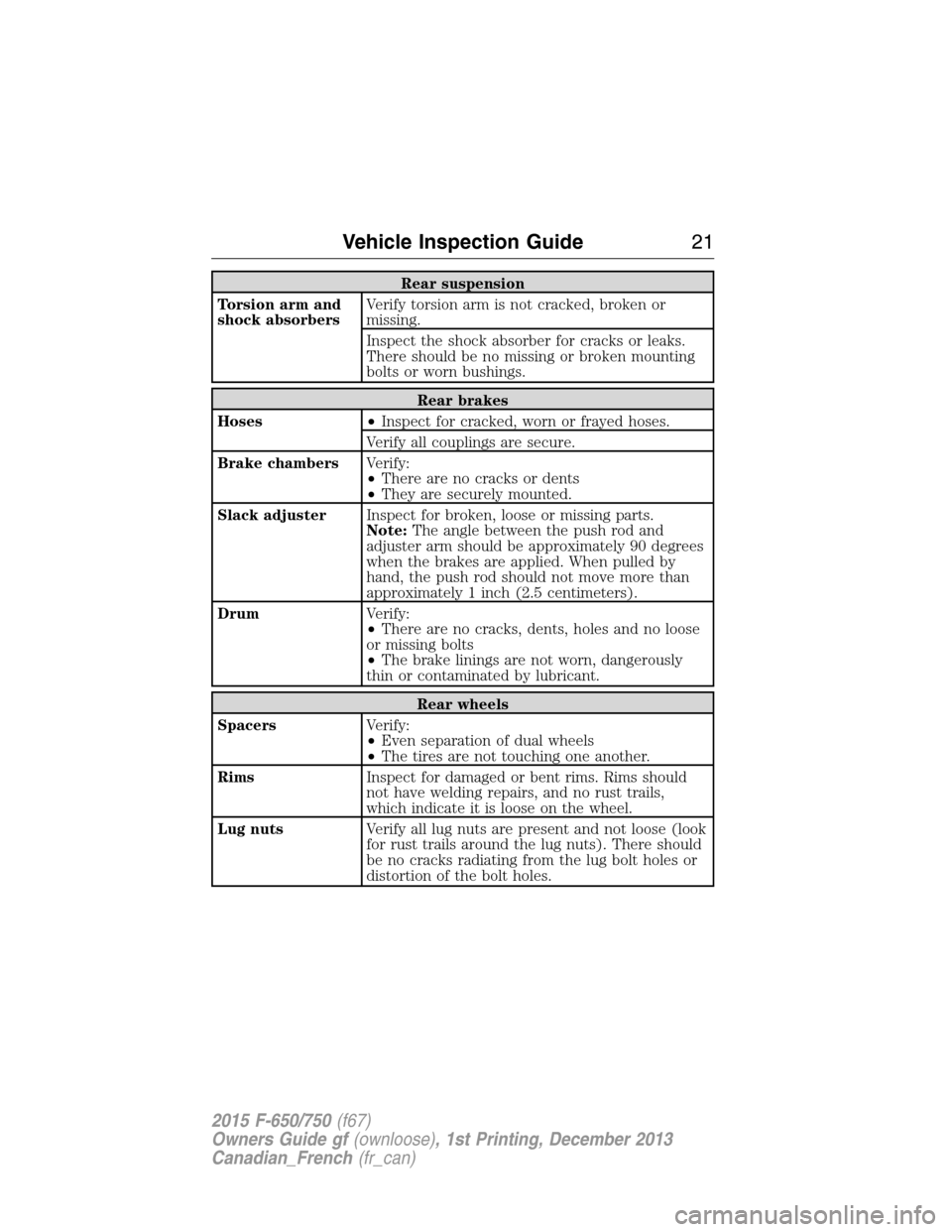
Rear suspension
Torsion arm and
shock absorbersVerify torsion arm is not cracked, broken or
missing.
Inspect the shock absorber for cracks or leaks.
There should be no missing or broken mounting
bolts or worn bushings.
Rear brakes
Hoses•Inspect for cracked, worn or frayed hoses.
Verify all couplings are secure.
Brake chambersVerify:
•There are no cracks or dents
•They are securely mounted.
Slack adjusterInspect for broken, loose or missing parts.
Note:The angle between the push rod and
adjuster arm should be approximately 90 degrees
when the brakes are applied. When pulled by
hand, the push rod should not move more than
approximately 1 inch (2.5 centimeters).
DrumVerify:
•There are no cracks, dents, holes and no loose
or missing bolts
•The brake linings are not worn, dangerously
thin or contaminated by lubricant.
Rear wheels
SpacersVerify:
•Even separation of dual wheels
•The tires are not touching one another.
RimsInspect for damaged or bent rims. Rims should
not have welding repairs, and no rust trails,
which indicate it is loose on the wheel.
Lug nutsVerify all lug nuts are present and not loose (look
for rust trails around the lug nuts). There should
be no cracks radiating from the lug bolt holes or
distortion of the bolt holes.
Vehicle Inspection Guide21
2015 F-650/750(f67)
Owners Guide gf(ownloose), 1st Printing, December 2013
Canadian_French(fr_can)
Page 241 of 384
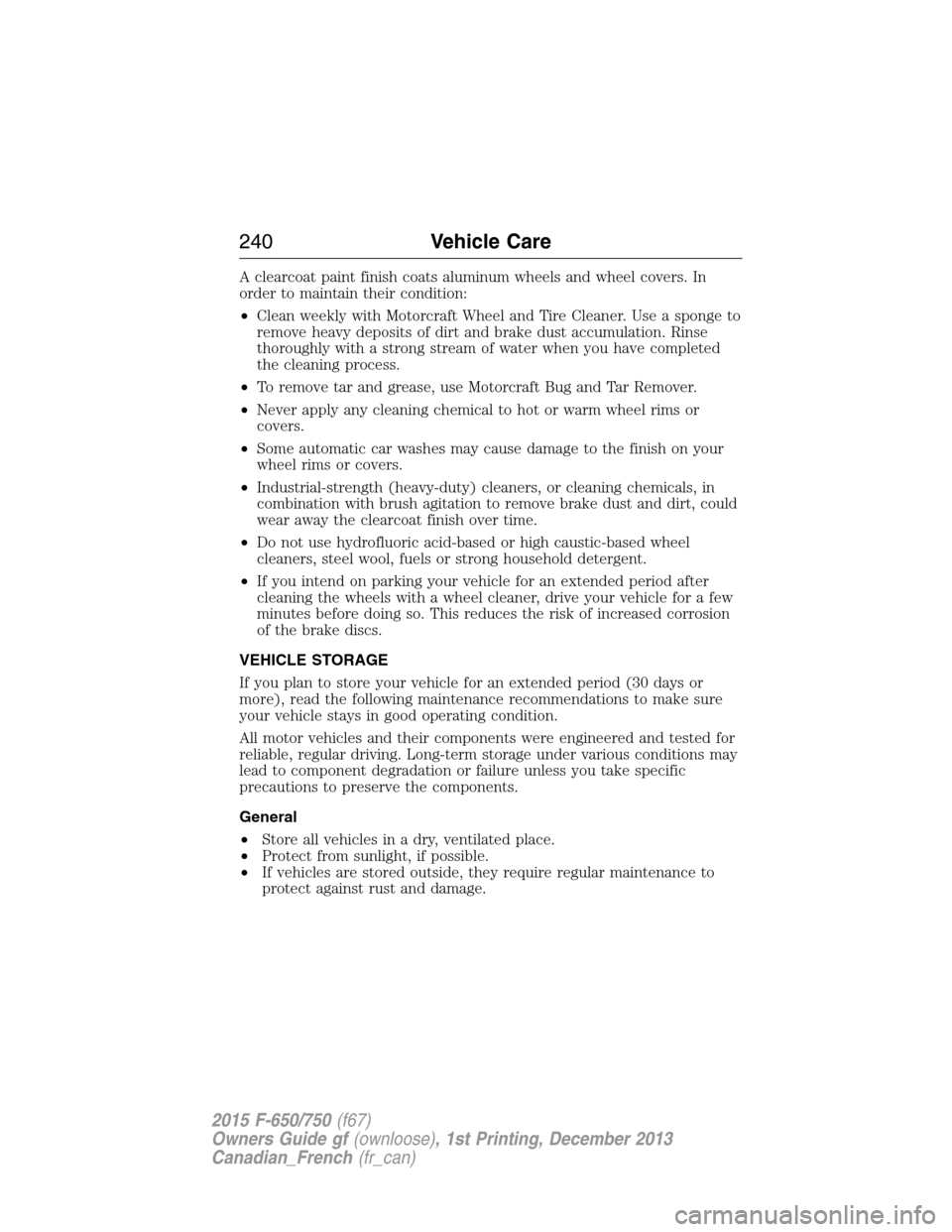
A clearcoat paint finish coats aluminum wheels and wheel covers. In
order to maintain their condition:
•Clean weekly with Motorcraft Wheel and Tire Cleaner. Use a sponge to
remove heavy deposits of dirt and brake dust accumulation. Rinse
thoroughly with a strong stream of water when you have completed
the cleaning process.
•To remove tar and grease, use Motorcraft Bug and Tar Remover.
•Never apply any cleaning chemical to hot or warm wheel rims or
covers.
•Some automatic car washes may cause damage to the finish on your
wheel rims or covers.
•Industrial-strength (heavy-duty) cleaners, or cleaning chemicals, in
combination with brush agitation to remove brake dust and dirt, could
wear away the clearcoat finish over time.
•Do not use hydrofluoric acid-based or high caustic-based wheel
cleaners, steel wool, fuels or strong household detergent.
•If you intend on parking your vehicle for an extended period after
cleaning the wheels with a wheel cleaner, drive your vehicle for a few
minutes before doing so. This reduces the risk of increased corrosion
of the brake discs.
VEHICLE STORAGE
If you plan to store your vehicle for an extended period (30 days or
more), read the following maintenance recommendations to make sure
your vehicle stays in good operating condition.
All motor vehicles and their components were engineered and tested for
reliable, regular driving. Long-term storage under various conditions may
lead to component degradation or failure unless you take specific
precautions to preserve the components.
General
•Store all vehicles in a dry, ventilated place.
•Protect from sunlight, if possible.
•If vehicles are stored outside, they require regular maintenance to
protect against rust and damage.
240Vehicle Care
2015 F-650/750(f67)
Owners Guide gf(ownloose), 1st Printing, December 2013
Canadian_French(fr_can)
Page 244 of 384

TIRES
Tire Inflation Information
WARNING:Always maintain your tires in good condition.
Frequently check and maintain correct inflation pressures as
specified by tire manufacturers. Inspect periodically for abnormal wear
patterns and repair/replace cut or broken tire casings. Always use
experienced, trained personnel with proper equipment and correct
procedures to mount or remove tires and wheels. Failure to adhere to
these warnings could result in wheel or tire malfunction, damage to
your vehicle, personal injury, or death.
WARNING:To avoid personal injury or death, always follow
these instructions when mounting radial tires on wheels:
•Only personnel that have had proper training and experience should
mount or remove tires from rims or wheels.
•Use only heavy-duty rims or approved rims for radial tires. It may be
necessary to contact your wheel and rim distributor to determine if
you can use radial tires with your rims.
•If you are using a tube, make sure to use special radial tire tubes
because of the increased flexing of the sidewalls on radial tires.
•Never use anti-freeze, silicones, or petroleum-based lubricants when
mounting radial tires. Make sure to use only an approved lubricant as
an aid for mounting tires.
•Always inflate tires in a safety cage.
•Do not attempt to mix stud piloted wheels or fasteners with hub
piloted wheels or fasteners. To do so may cause premature wheel
failure resulting in property damage, personal injury, or death.
•Do not mix foreign (not made in North America) wheel-mounting
parts with domestic (made in North America) parts. Many foreign
wheel components look similar to, but are not the same as domestic
made components. Mixing components could cause wheel or fastener
failures and result in property damage, personal injury, or death.
Wheels and Tires243
2015 F-650/750(f67)
Owners Guide gf(ownloose), 1st Printing, December 2013
Canadian_French(fr_can)
Page 251 of 384
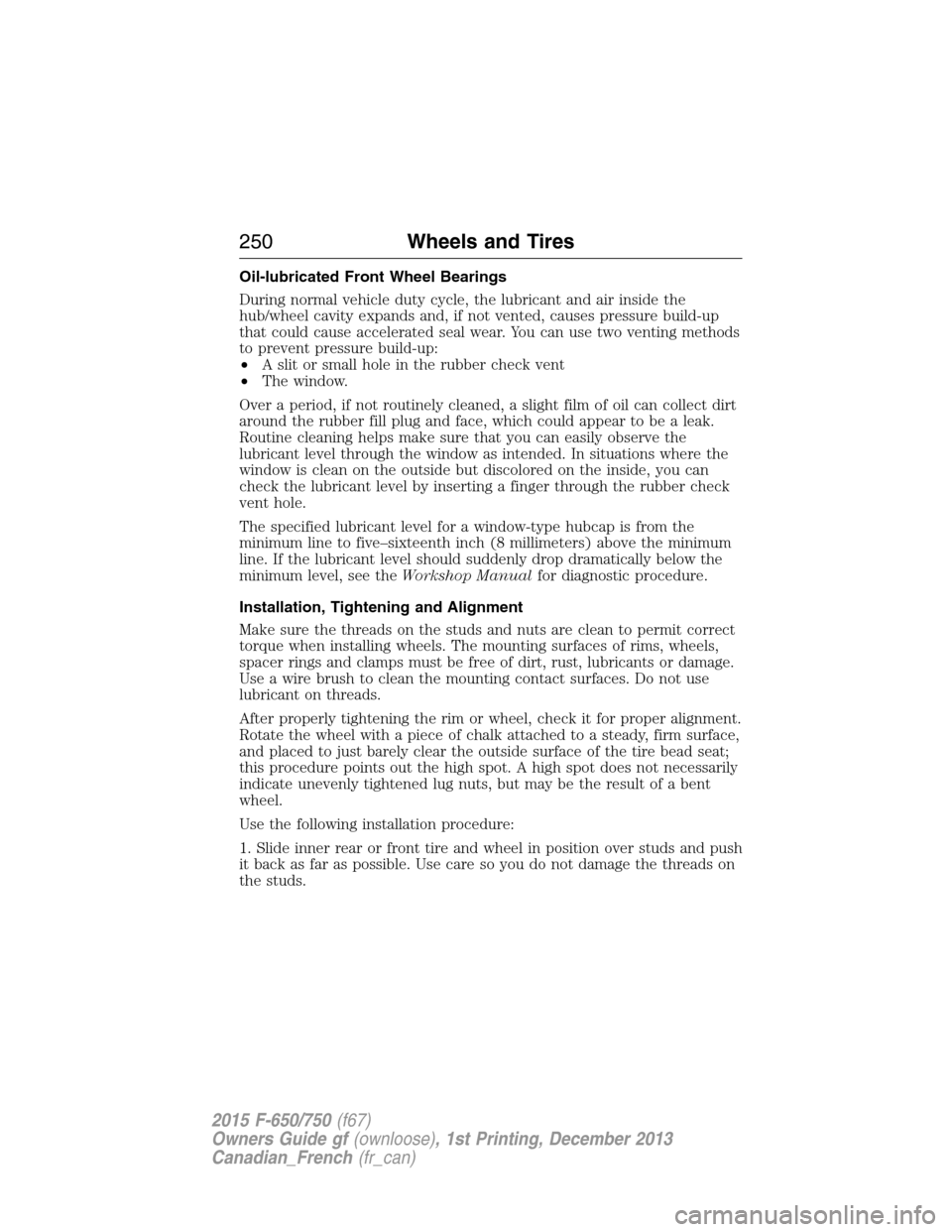
Oil-lubricated Front Wheel Bearings
During normal vehicle duty cycle, the lubricant and air inside the
hub/wheel cavity expands and, if not vented, causes pressure build-up
that could cause accelerated seal wear. You can use two venting methods
to prevent pressure build-up:
•A slit or small hole in the rubber check vent
•The window.
Over a period, if not routinely cleaned, a slight film of oil can collect dirt
around the rubber fill plug and face, which could appear to be a leak.
Routine cleaning helps make sure that you can easily observe the
lubricant level through the window as intended. In situations where the
window is clean on the outside but discolored on the inside, you can
check the lubricant level by inserting a finger through the rubber check
vent hole.
The specified lubricant level for a window-type hubcap is from the
minimum line to five–sixteenth inch (8 millimeters) above the minimum
line. If the lubricant level should suddenly drop dramatically below the
minimum level, see theWorkshop Manualfor diagnostic procedure.
Installation, Tightening and Alignment
Make sure the threads on the studs and nuts are clean to permit correct
torque when installing wheels. The mounting surfaces of rims, wheels,
spacer rings and clamps must be free of dirt, rust, lubricants or damage.
Use a wire brush to clean the mounting contact surfaces. Do not use
lubricant on threads.
After properly tightening the rim or wheel, check it for proper alignment.
Rotate the wheel with a piece of chalk attached to a steady, firm surface,
and placed to just barely clear the outside surface of the tire bead seat;
this procedure points out the high spot. A high spot does not necessarily
indicate unevenly tightened lug nuts, but may be the result of a bent
wheel.
Use the following installation procedure:
1. Slide inner rear or front tire and wheel in position over studs and push
it back as far as possible. Use care so you do not damage the threads on
the studs.
250Wheels and Tires
2015 F-650/750(f67)
Owners Guide gf(ownloose), 1st Printing, December 2013
Canadian_French(fr_can)
Page 343 of 384
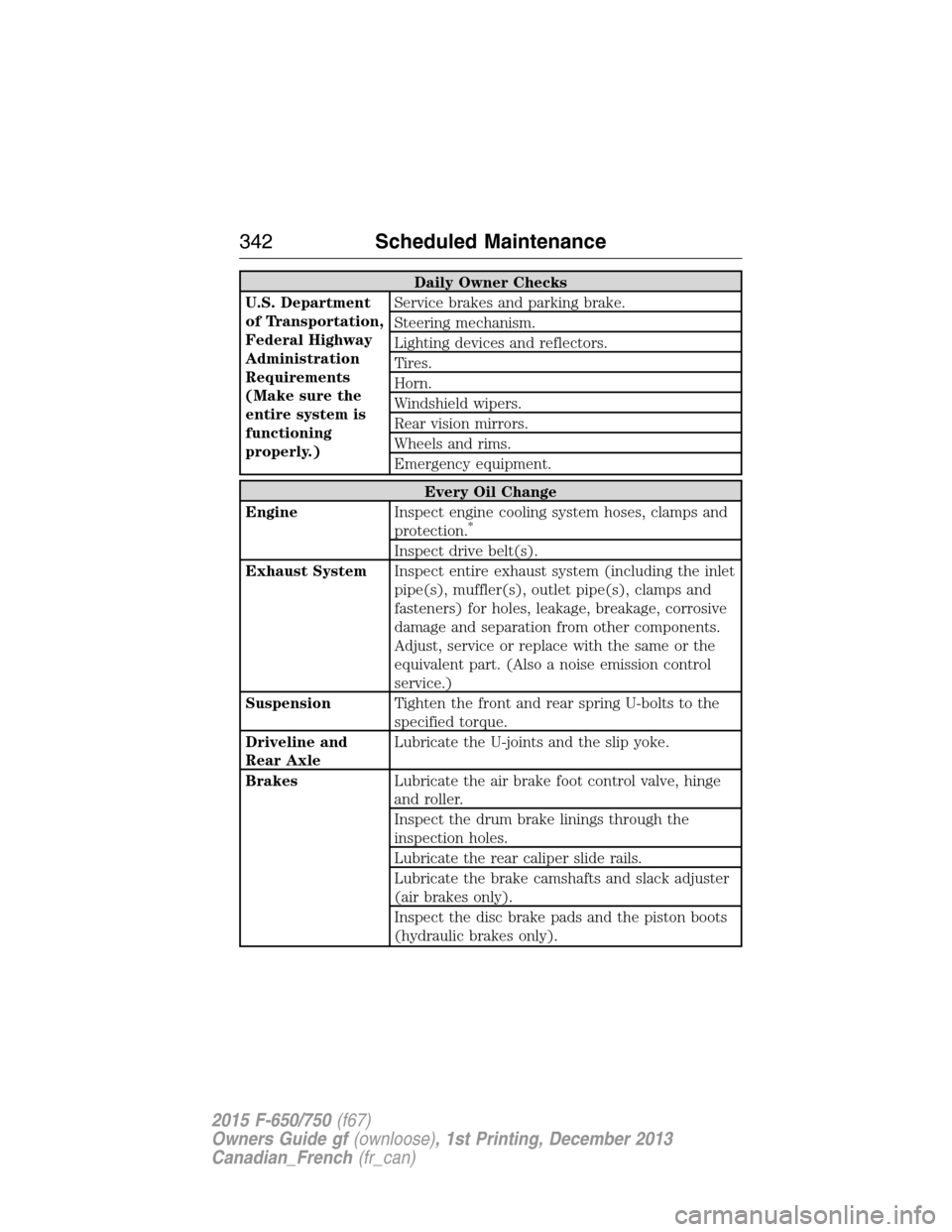
Daily Owner Checks
U.S. Department
of Transportation,
Federal Highway
Administration
Requirements
(Make sure the
entire system is
functioning
properly.)Service brakes and parking brake.
Steering mechanism.
Lighting devices and reflectors.
Tires.
Horn.
Windshield wipers.
Rear vision mirrors.
Wheels and rims.
Emergency equipment.
Every Oil Change
EngineInspect engine cooling system hoses, clamps and
protection.
*
Inspect drive belt(s).
Exhaust SystemInspect entire exhaust system (including the inlet
pipe(s), muffler(s), outlet pipe(s), clamps and
fasteners) for holes, leakage, breakage, corrosive
damage and separation from other components.
Adjust, service or replace with the same or the
equivalent part. (Also a noise emission control
service.)
SuspensionTighten the front and rear spring U-bolts to the
specified torque.
Driveline and
Rear AxleLubricate the U-joints and the slip yoke.
BrakesLubricate the air brake foot control valve, hinge
and roller.
Inspect the drum brake linings through the
inspection holes.
Lubricate the rear caliper slide rails.
Lubricate the brake camshafts and slack adjuster
(air brakes only).
Inspect the disc brake pads and the piston boots
(hydraulic brakes only).
342Scheduled Maintenance
2015 F-650/750(f67)
Owners Guide gf(ownloose), 1st Printing, December 2013
Canadian_French(fr_can)